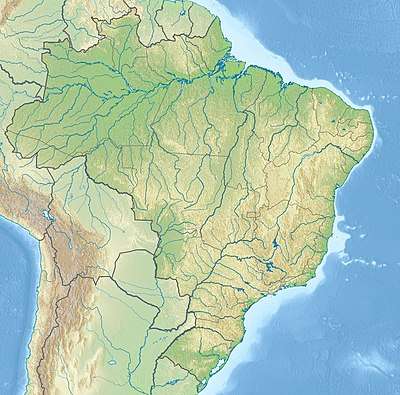Mata da Estrela Private Natural Heritage Reserve
Mata da Estrela Private Natural Heritage Reserve (Portuguese: Reserva Particular do Patrimônio Natural Mata da Estrela) is a private natural heritage reserve in the state of Rio Grande do Norte, Brazil.
| Mata da Estrela Private Natural Heritage Reserve | |
|---|---|
| Reserva Particular do Patrimônio Natural Mata da Estrela | |
 Mata Estrela Reserve | |
 | |
| Nearest city | Baía Formosa, Rio Grande do Norte |
| Coordinates | 6°24′25″S 34°59′28″W |
| Area | 2,039.93 hectares (5,040.8 acres) |
| Designation | Private natural heritage reserve |
| Created | 30 March 2000 |
Location
The reserve is in the municipality of Baía Formosa in Rio Grande do Norte, and covers 2,039.93 hectares (5,040.8 acres). It is owned by Destilaria Baía Formosa and is part of the 7,897 hectares (19,510 acres) Fazenda Pedrosa in the municipality of Baía Formosa, Rio Grande do Norte.[1] The reserve was created on 30 March 2000 by Marilia Marreco Cerqueira, President of the Brazilian Institute of Environment and Renewable Natural Resources (IBAMA).[2] It takes its name Mata da Estrela (Star Forest) from its shape.[3] The forest is beside the sea on dunes.[4]
Environment
The reserve holds a remnant of Atlantic Forest in an area that was largely deforested to make way for sugar cane plantations. The forest is open to visitors who wish to experience the varied flora and fauna. A local guide will interpret the environment. The reserve holds the Lagoa Araraquara, also called the Coca-Cola Lagoon due to its dark colour.[3] Pau-Brasil (Caesalpinia echinata) is native to the forest. There are Gameleira trees (of the family Moraceae) with a diameter equal to 8 men holding hands. The fauna and flora of the forest are being mapped and described by NGOs and universities authorized by the owner.[4]
Notes
Sources
- Marilia Marreco Cerqueira (30 March 2000), Portaria No 20, de 30 de Marco de 2000 (PDF) (in Portuguese), retrieved 2016-05-18
- "Mata Estrela e Lagoa", baiaformosa.com.br (in Portuguese), retrieved 2016-05-18
- RPPN – Mata Estrela (in Portuguese), Grupo Farias, retrieved 2016-05-18
- RPPN Mata Estrela (in Portuguese), ICMBio, retrieved 2016-05-18